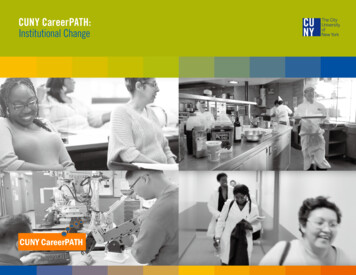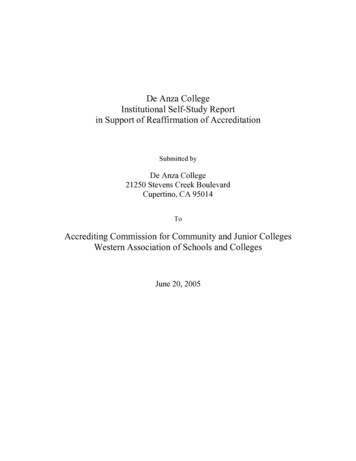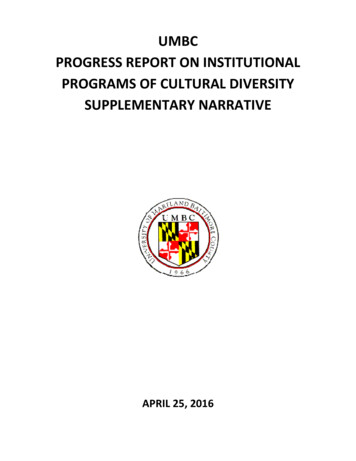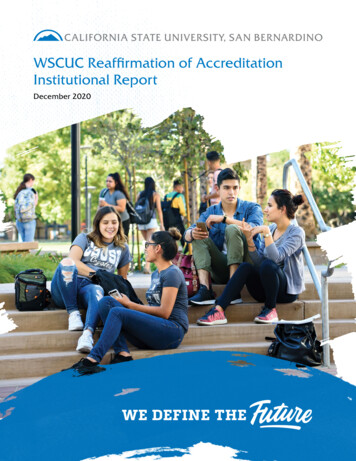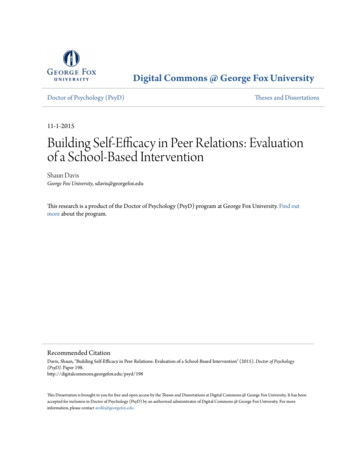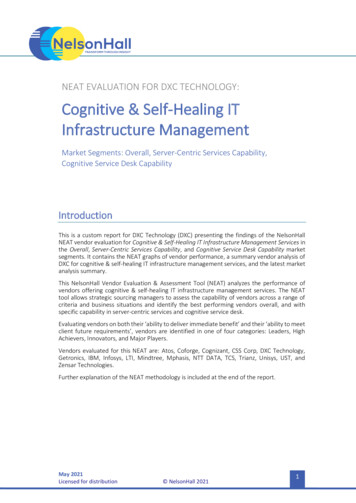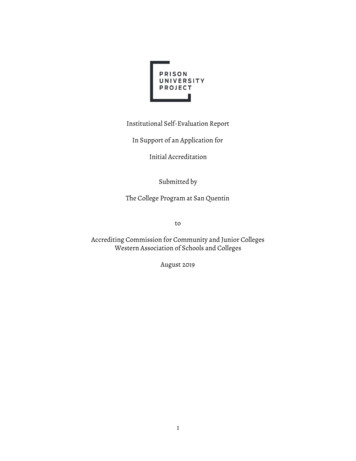
Transcription
Institutional Self-Evaluation ReportIn Support of an Application forInitial AccreditationSubmitted byThe College Program at San QuentintoAccrediting Commission for Community and Junior CollegesWestern Association of Schools and CollegesAugust 20191
CertificationTo:Accrediting Commission for Community and Junior CollegesWestern Association of Schools and CollegesFrom: Jody LewenCollege Program at San QuentinPO Box 492San Quentin, CA 94964This Institutional Self-Evaluation Report is submitted to the ACCJC for the purpose of assistingin the determination of the institution’s accreditation status.I certify there was effective participation by the campus community, and I believe theSelf-Evaluation Report accurately reflects the nature and substance of this institution.Signatures:Jody LewenExecutive Director[8/21/19]Maddy Russell-ShapiroChairperson, Governing Board[8/21/19]Amy JamgochianAcademic Program Director[8/21/19]Theresa RoederChair of the Board Accreditation Working Group, Faculty member[8/21/19]2
NOTE: Suggested total ISER page limit is 250 pages.ContentsCertificationCollege HistoryPartnership and IndependenceNaming ConventionsStudent Enrollment DataStudent Demographic DataEligibility Requirement 1: AuthorityEligibility Requirement 2: Operational StatusEligibility Requirement 3: DegreesEligibility Requirement 4: Chief Executive OfficerEligibility Requirement 5: Financial AccountabilityPublic Notification of an Evaluation Team Visit and Third Party CommentStandards and Performance with Respect to Student AchievementCredits, Program Length, and TuitionTransfer PoliciesDistance Education and Correspondence EducationStudent ComplaintsInstitutional Disclosure and Advertising and Recruitment MaterialsTitle IV ComplianceStandard I: Mission, Academic Quality and Institutional Effectiveness, and IntegrityA. MissionConclusions on Standard I.A. MissionB. Assuring Academic Quality and Institutional EffectivenessAcademic QualityInstitutional EffectivenessConclusions on Standard I.B. Academic Quality and Institutional EffectivenessC. Institutional IntegrityConclusions on Standard I.C. Institutional IntegrityStandard II: Student Learning Programs and Support ServicesA. Instructional ProgramsConclusions on Standard II.A. Instructional 38495759767979106
B. Library and Learning Support ServicesConclusions on Standard II.B. Library and Learning Support ServicesC. Student Support Services108114116Standard III: ResourcesA. Human ResourcesConclusions on Standard III.A. Human ResourcesB. Physical ResourcesConclusions on Standard III.B. Physical ResourcesC. Technology ResourcesConclusions on Standard III.C. Technology ResourcesD. Financial ResourcesPlanningFiscal Responsibility and StabilityLiabilitiesContractual AgreementsConclusions on Standard III.D. Financial andard IV: Leadership and GovernanceA. Decision-making Roles and ProcessesConclusions on Standard IV.A. Decision Making Roles and ProcessesB. Chief Executive OfficerConclusions on Standard IV.B. CEOC. Governing BoardConclusions on Standard IV.C. Governing BoardD. Multi-College Districts or Systems1821821951952032032172184
IntroductionCollege HistoryThe College Program at San Quentin (CPSQ) is one of the largest and longest-running prisonhigher education programs in the United States. It was established shortly after passage of the1994 Violent Crime Control and Law Enforcement Act barred incarcerated people fromreceiving Pell Grants, effectively ending higher education in prison in the U.S. At that time,virtually all of the approximately 350 programs around the country shut down for lack of funds.CPSQ was founded through the collaborative efforts of administrators at Patten College (laterPatten University), the Education Department of San Quentin, and a faculty member at UCDavis. Since its founding, CPSQ has offered a general education Associate of Arts degree inGeneral Studies. The AA degree has been run as an extension site of Patten; students enrolled incredit courses at CPSQ are registered at Patten, and Patten has conferred credits and degrees.Any person in the mainline population of San Quentin with a high school diploma or GED iseligible to enroll, without regard to age, c ommitment offense, sentence length, or time left toserve. St udents are charged no tuition or fees, and all instructional staff in the program havebeen volunteers.Key developments in the history of the college include: 1996: CPSQ began with two classes, a volunteer coordinator (a San Quentin State PrisonEducation Department staff member), and no budget. 2000: Jody Lewen (the current Executive Director) became the Volunteer ProgramCoordinator for CPSQ and Extension Site Director for Patten College at San Quentin.Course offerings at this time included all requirements and electives for the AA degreein General Studies, as well as two non-credit College Preparatory courses, Math 50 andEnglish 99. Student support services at this time included study hall tutoring. 2000 - 2003: The program continued to develop and expand. With the support of theProgram Coordinator, teams of faculty planned and implemented improvements to theinstructional programs. The College Preparatory program expanded from two to fivecourses. Academic advising was added. 2003 - 2005: The Prison University Project was formed to provide material,administrative, and financial support to the College Program. Initial fiscal sponsorshipwas obtained from the Tides Center. The formation of the Prison University Projectgreatly facilitated the Program’s fundraising efforts as well as enhancing its ability tomanage its own finances. The Program Coordinator and an additional ProgramAdministrator position became paid positions. Academic advising and responsibility forvolunteer faculty’s security clearances were assumed by paid academic staff. Electives in5
math and foreign language were added to course offerings to satisfy UC and CSUtransfer requirements. 2006: The Prison University Project was incorporated as an independent 501(c)(3)non-profit with a governing Board, partially as a condition of a grant from the SunshineLady Foundation. Jody Lewen was named Executive Director of the Prison UniversityProject, as well as the Extension Site Director of Patten College at San Quentin. 2007: The Prison University Project acquired its own office space. A third paidAdministrative Assistant position was created. 2009 - 2015: The College Program and the Prison University Project entered a period ofexpansion, both in terms of paid staff and in terms of the classes and support servicesoffered to CPSQ students. Paid staff members were added in development,communications, operations, and academic program oversight. With the support ofpaid staff, teams of faculty continued to plan and implement improvements to theinstructional programs. Lab sciences were added in this period, allowing students tosatisfy all UC and CSU transfer requirements. Additionally, co-curricular activities andacademic workshops were introduced. Training for faculty beyond the introductorytraining was also developed. 2014: California passed Senate Bill 1391, allowing California Community Colleges toreceive apportionment funding for teaching inside state prisons. The CaliforniaCommunity College Chancellor’s Office formed a consulting relationship with thePrison University Project, to receive technical assistance and advice as four statecommunity colleges launched pilot programs. 2015: Dr. Amy Jamgochian was hired as the first paid Academic Program Director tooversee all instructional programs and to directly coordinate credit courses. The PrisonUniversity Project began advising and supporting various program sites and providingmulti-day trainings to interested community college faculty and administrators. 2016: PUP was awarded the National Humanities Medal by President Obama. 2018: Patten University (formerly Patten College) informed CPSQ students of its plannedclosure. The leadership of the Prison University Project decided to seek independentaccreditation.Today, the College Program continues to provide an Associate of Arts degree program inGeneral Studies and a robust College Preparatory program. Each academic year, the CollegeProgram at San Quentin places close to 300 instructors, tutors, research assistants, and otherfaculty, and serves more than 400 unique students. The Prison University Project (PUP), thenonprofit that administers the College Program, has continued to expand. From two paid staffmembers at its inception, PUP now employs sixteen paid staff members, includingDevelopment and Communications staff, Operations staff, and Program Team staff chargedwith the administration of the academic programs. (A-1 CPSQ History)6
Partnership and IndependenceOver its many years of partnership with PUP / CPSQ, Patten University has undergone anumber of fundamental changes. These included Patten’s acquisition by UniversityNow, anorganization focused on online education, and Patten’s subsequent transformation from anonprofit faith-based institution to a for-profit secular institution. In addition to changes in itsmission, Patten has undergone periods of financial instability that raised concerns about itsreliability as a partner. While the Prison University Project has funded all College Programoperations independently since 2003, instability at Patten threatened the accredited AA degreeprogram. In light of this, the leadership of PUP / CPSQ spent many years investigatingalternative partnership arrangements. These attempts were unsuccessful; for a variety ofreasons ranging from potential partners’ financial situation, reluctance to confer degrees onincarcerated students, and lack of mission fit with the College Program, no new partnershipwas realized. (A-2 Town Hall Agenda)Given the unique needs of CPSQ’s student body and the college’s historical and continuingcommitment to radical equity and inclusivity, independence will best ensure the continuedfulfillment of its mission. In seeking accreditation, PUP/ CPSQ hopes to become the firstindependent college in the United States with a primary focus on students who areincarcerated.Naming conventionsFor ease of reading, the following conventions are used throughout this document.CPSQ or the College Program refers to the College Program at San Quentin, founded in 1996,whose instructional programs currently consist of a single AA degree program in GeneralStudies and a College Preparatory program.PUP refers to the Prison University Project (PUP), which has administered the College Programsince 2003. PUP was registered as a 501(c)(3) in 2006, and operates inside San Quentin StatePrison with the authorization of the California Department of Corrections and Rehabilitation(CDCR).PUP / CPSQ refers to the organization consisting of the Prison University Project (PUP) and theacademic offerings it administers. As PUP transitions away from partnership with PattenUniversity, PUP will undergo a legal name change to signal its status as an independent college.PUP / CPSQ will be a single independent institution of higher education, referred to by a singlename.Staff refers to the paid staff of the Prison University Project (PUP). Paid staff directlyresponsible for the academic and operational administration of the College Program areemployed by PUP.7
The Program Team refers to PUP’s paid staff and two incarcerated Program Clerks directlyresponsible for administering and coordinating academic offerings and support services insideSan Quentin. Members of the Program Team escort faculty in and out of the prison, facilitatesfaculty and other staff communication with students, and provides academic advising andother forms of support to students.The Academic Team refers to the subset of the Program Team with direct responsibility foracademic quality, faculty placements and training, supervising courses and study hall, andcoordinating planning meetings and continuous improvement activities with faculty. Allmembers of the Academic Team have academic credentials and experience appropriate to theirroles.Faculty refers to the volunteer educational personnel placed in the instructional programs anddirectly related services each term. Faculty include instructors, tutors, research assistants,teaching assistants, and co-curricular workshop leaders. All faculty serve as volunteers.Custody staff or prison administrators refers to the employees of San Quentin State Prison andthe California Department of Corrections and Rehabilitation (CDCR). Custody staff includecorrections officers responsible for security, safety, and supervision of incarcerated people atSan Quentin. Prison administrators include prison counselors, employees of the prison’sEducation Department, etc.Consultants refers to individuals engaged on a contract basis by PUP to support paid staff,usually in capacity building work. Current consultants include: Kirsten Pickering, CPSQ’s Accreditation Liaison Officer and former CPSQ facultymember Dr. Melanie Booth, consultant for educational effectiveness and accreditation, and thecurrent Associate Vice President for Institutional Effectiveness at Dominican Universityof California Dr. Mary Ellen Petrisko, consultant for accreditation and former president of WASCSenior College and University Commission Julia Odom, consultant for PUP’s Student Information System vendor selection processand current registrar at California State University Maritime Academy Stacey Smith, consultant for organizational development and partner at ContigoPartners Esther Kim, consultant for organizational development and head of Esther KimConsultingPartners r efers to individuals or institutions providing free or low cost services or advising toPUP / CPSQ on an ongoing basis. Current partners include:8
Drs. Amy Lerman and Meredith Sadin of UC Berkeley’s Goldman School of Public Policy The National Institute of Learning Outcomes Assessment (NILOA) JSTOR/Ithaka UCSF’s Science and Health Education Partnership (SEP) Monterey County Free Library (MCFL) The California Department of Corrections and Rehabilitation (CDCR) San Quentin State PrisonStudent Enrollment DataAll students in the College Program are enrolled at its single campus, located inside SanQuentin State Prison (San Quentin, CA 94964).The College Program calculates its annual unduplicated headcount using course enrollment forthe three academic terms in each calendar year. For example, the unduplicated headcount for2016 is based on unique students enrolled in courses in Spring, Summer, and Fall of 2016.Before each academic term, students register for credit and non-credit courses. Uniquestudents who remained enrolled in at least one course past the add/drop deadline for each termare included in the headcount for that year. These include students later granted an“administrative drop.” Administrative drops are given by staff when students are preventedfrom attending due to institutional obstacles. Such obstacles may include involuntary transferaway from San Quentin, parole, segregation for safety or discipline, and quarantine orlockdown of students’ housing unit for a significant period during the semester.The College Program also tracks oriented students (aka “active students”). After attending anorientation, students are considered “active” in the College Program (eligible to register forcourses and other activities) while they remain at San Quentin, unless they request removalfrom the program. Active students may include graduates of the College Program. (Graduatesat San Quentin may continue to audit courses, space permitting, and participate in otherprogram events.) As of Summer 2019, approximately 700 students are active at CPSQ.As the table below indicates, unduplicated headcounts for the past three full years (includingthe Spring, Summer, and Fall terms of each year) show a steady increase in students enrolled inall courses at CPSQ.9
Unduplicated yearly headcountRegistrationtypeDefinitionSP-FA 2016SP-FA 2017SP-FA 20183-yr averCredit courseheadcountUniquestudentsenrolled in atleast one creditcourse afterdrop periodends entsenrolled in atleast onenon-creditcourse afterdrop periodends (#)185242273233All coursesheadcountUniquestudentsenrolled in atleast one courseafter dropperiod ends (#)342419476412Note: Headcount includes auditors (who must officially enroll in courses and maintainattendance) and students administratively dropped from courses after the general enrollmentperiod ends.“Administrative drops” are given when students are removed from courses by the prisonadministration in a given term. Reasons for removal include involuntary transfer away fromSan Quentin, parole, segregation for safety or discipline, and quarantine or lockdown ofstudents’ housing unit for a significant period during the semester.While CPSQ staff track student course loads, they do not use the notion of an FTE student forseveral reasons, including: Student Time : Students very rarely enroll in 15 credits in a given term in the AA degreeprogram. Many students have conflicts that prevent them from taking courses atavailable times, including mandatory jobs inside the prison and enrollment incourt-mandated rehabilitative programs.10
Class Scheduling : CPSQ only has access to at most six classrooms at any given time.With the exception of Friday mornings, courses can only be offered in the afternoonsand evenings, due to competing demands on classroom space.The course load calculations below exclude non-credit course enrollments, enrollments byauditors, and enrollments later dropped by students or administratively dropped by staff.Enrollments for each year include three academic terms, in the spring, summer, and fall.Student yearly credit course loadCredit courseunits per yearDefinition 4 unitsSP-FA 2016SP-FA 2017SP-FA 20183-yr averPercentage of40%students takingcredit coursesenrolled infewer than 4credit courseunits during theyear38%38%38%4 to 8 unitsPercentage of22%students takingcredit coursesenrolled in 4 to8 credit courseunits during theyear23%25%23% 8 unitsPercentage of38%students takingcredit coursesenrolled inmore than 8credit courseunits during theyear40%38%38%Note: All credit courses are 3 units, except lab science courses, which are 4 units. Course loadcalculations exclude enrollments in non-credit courses, audits, and enrollments dropped bythe add/drop deadline or administratively dropped.11
Student Demographic DataCPSQ collects a range of demographic data from entering students, including: Gender identificationDate of birthPlace of birthCitizenship statusVeteran statusRace/ethnicityNative language and languages spokenCDC Housing assignmentGoals for enrollment in the College ProgramPast educational historyWith the exception of verifying GED/High School transcripts and updating student housingassignments in collaboration with prison administrators, CPSQ relies on students’ self-reportfor demographic data. For example, CPSQ does not currently partner with CDCR in order togather student birth dates or race/ethnicity data.Student demographic dataDemographic data for all students SP-FA 2016registered in a College Programcourse when the generalenrollment period endsSP-FA 2017SP-FA 20182016-2018Race/ethnicity: number and percentage of students self-identifying as in groupAsian23 / 7%27 / 6%34 / 7%84 / 7%Black/African- American175 / 51%207 / 49%232 / 49%614 / 50%Latino/Hispanic38 / 11%60 / 14%61 / 13%159 / 13%White/Anglo62 / 6%81 / 19%98 / 21%241 / 19%Native American11 / 3%14 / 3%10 / 2%35 / 3%Pacific Islander6 / 2%8 / 2%10 / 2%24 / 2%Decline to State /Unknown14 / 4%15 / 4%20 / 4%49 / 4%Other15 / 4%18 / 4 %18 / 4%51 / 4%12
Age: number and percentage of students in age range18 to 2412 / 4%38 / 9%52 / 11%102 / 8%25 to 3431
2018: Patten University (formerly Patten College) informed CPSQ students of its planned closure. The leadership of the Prison University Project decided to seek independent accreditation. Today, the College Program continues to provide an Associate of Arts degree program in
